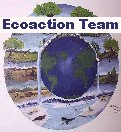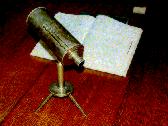Announcements and News:
Site Navigation: 




 Page Info:
Page Info:
File created: Sep 5,
1998
Announcements and News: |
CLASS #: 1 DATE: Aug 30, 1999
TOPIC: Course Overview FORMAT: group;lec
When you are done studying this lesson, you should be able to:
1. Outline the course sequence
2. Describe the mechanics of the course.
3. Associate current news with this course
CLASS OUTLINE:
1. Welcome, check schedules, Assignment Sheet - h/o
2. Seats
3. Course Overview - h/o
4. Textbooks
5. Recent EESci news
HOMEWORK:
1. All classes: Cover, inspect textbook, record damage.
2. Honors: list pages and chapters that will be used for each course section. Standard
classes: Do Textbok Inventory h/o.
3. All classes: Find, cut out article on Earth topic, put in notebook before 1st grading.
CLASS #: 1 DATE: Aug 30, 1999
TOPIC: Why EESci? Lab Exercise FORMAT: lab
When you are done studying this lesson, you should be able to:
1. Describe predicted changes and causes in world population, and
2. Describe how increasing population will affect your life.
3. Relate increasing population to the need for better mangement of natural resources,
which will require knowledge, which requires science.
CLASS OUTLINE: 
1. Hand in text reports
2. Any questions on course overview?
3. Text inventory examples
4. Intro to Foundations Section of Course - h/o
5. Intro to Why EESci research - h/o, sources of info
6. Work on packet.
HOMEWORK:
1. Finish lab exercise due at next lab.
CLASS #: 2 DATE: Aug 31, 1999
TOPIC: Natural resources FORMAT: lec;demo 
When you are done studying this lesson, you should be able to:
1. distinguish between renewable and nonrenewable resources, and
2. given a description of a resource, classify it as renewable or nonrenewable.
3. Define and give examples of natural resources.
CLASS OUTLINE:
1. Why EESci examples, questions
2. Intro to resources -renewable and nonrenewable
3. Examples of nonrenewable and renewable resources
HOMEWORK:
In notebook, list 20 things you used today that came from natural resources.
CLASS #: 3 DATE: Sep 1, 1999
TOPIC: Renewable, Nonrenewable Resource Decisions FORMAT: lec;video
When you are done studying this lesson, you should be able to:
1. Classify resources as renewable or nonrenewable based on the length of time for nature
to return them after use.
2. Identify renewable resources as more appropriate for use if all other factors affecting
resource choice are equal.
CLASS OUTLINE:
1. Resource list,
2. Management and the coffee cup matrix,
3. Types of information
4. Every day planning
HOMEWORK:
Describe how you manage something in terms of the management cycle, and classify each
natural resource that you listed yesterday as renewable, nonrenewable or "need more
information".
CLASS #: 4 DATE: Sep 2, 1999
TOPIC: Management and the Scientific Method FORMAT: lec; group
When you are done studying this lesson, you should be able to:
1. Explain with examples how acquisition of knowledge is related to management of natural
resources.
2. Define science.
3. List steps in a scientific method.
4. Relate experiments to the testing of hypotheses.
CLASS OUTLINE:
1. Coffee cup reprise
2. Management and knowledge
3. Non-science sources of knowledge.
4. What Is Science? How does it work? - h/o
HOMEWORK:
1. Complete worksheet "How does Science Work?"
2. Honors classes read and do questions p 2-16. Standard classes read p2-22, do the
questions in the margins that are printed in blue, and p9 #1-3, p15 #4-7, p24 #3-5. (2
night assignment)
CLASS #: 5 DATE: Sep 3, 1999
TOPIC: How does Science Work? FORMAT: lec; group
When you are done studying this lesson, you should be able to:
1. Explain with examples how acquisition of knowledge is related to management of natural
resources.
2. Define science.
3. List steps in a scientific method.
4. Relate experiments to the testing of hypotheses.
CLASS OUTLINE:
1. What does science have to do with management?
2. Measurement observation vs inference
3. Objective and subjective knowledge
4. Inference and proof
HOMEWORK:
1. Complete worksheet "How does Science Work?"
2. Honors classes read and do questions p 2-16. Standard classes read p2-22, do the
questions in the margins that are printed in blue, and p9 #1-3, p15 #4-7, p24 #3-5. (2
night assignment)
Environmental Earth Science Assignment Sheet - Cycle 2
CYCLE 2 LAB DATE:
TOPIC: Mass/Graph Lab: Pennies FORMAT: lab
OBJECTIVES:
1. Use a triple beam balance scale to measure mass to an accuracy of +/- .05 gram.
2. Use a data table to construct a bar graph.
3. Explain control of variables and sources of error in a experiment.
BRIEF OUTLINE:
1. The Penny Problem.
2. Research, Hypothesis.
3. Design your experiment.
4. Measure pennies, record data on board.
HOMEWORK Pennies lab report rough draft in notebook.
CLASS #: 1 DATE: Sep 8, 1999
TOPIC: Experimental Design FORMAT: lec; note guide
OBJECTIVES:
1. Define a laboratory as a situation in which all variables can be controlled for the purpose of experimentation.
2. Design a laboratory and experiment to test a given hypothesis.
BRIEF OUTLINE:
1. Wrap up How Does Science Work? exercise.
2. Test hypothesis = experiment or fieldwork
3. Candle Factory mock experiment.
4. Design your own experiment.
HOMEWORK List examples of each term in the Candle Factory experiment. AND Honors: Design an experiment to test the hypothesis that leaves must be removed from the lawn in the fall.
CLASS #: 2 DATE: Sep 9 or 10, 1999
TOPIC: Measurement in Science: SI, Length FORMAT: lec;manip
OBJECTIVES
1. define measurement as a comparison to a standard.
2. measure length, area in SI.
3. Explain how SI prefixes indicate the size of SI units.
BRIEF OUTLINE:
1. Why measure?
2. SI (metric) basics.
3. The Meter Matters!
4. Internalize lengths
5. Decimal places.
HOMEWORK:
Identify things at home that are a meter long, centimeter long, 1 square meter area, 1 square centimeter area.
CLASS #: 3 DATE: Sep 10 or 13, 1999
TOPIC: Area in SI FORMAT: group;comp
OBJECTIVES
1. measure length to the proper decimal place.
2. determine rectangular surface area.
3. determine the volume of a rectangular solid using length.
BRIEF OUTLINE:
1. How far?
2. How many squares?
3. Surface area.
4. Surface area in Earth Science.
5. Conversions
HOMEWORK:
1. Metric practice h/o AND
2. Hon: Do p 18-20 and the SI questions from p24. Stan: Read 26-30, do blue questions in margins and #1-2 p29.
CLASS #: 4 DATE: Sep 13 or 14, 1999
TOPIC: Surface Area and Solid Volume FORMAT: lec;demo
OBJECTIVES
1. Explain the relationship between rectangular solid and fluid volumes in SI.
2. Convert SI measurements into other units.
BRIEF OUTLINE:
1. Area is not volume
2. Internalize the cubic centimeter.
3. The square meter.
4. Liquid volumes.
5. Volumes in Earth Science.
HOMEWORK:
Identify 1 sq cm and 1 sq meter objects at home.
CLASS #: 5 DATE: Sep 14 or 15, 1999
TOPIC: Liquid Volume, Mass and Weight FORMAT: individual tasks ;rev
OBJECTIVES
1. Define the gram as the mass of 1 ml of water.
2. Find the volume of an irregular solid by using displacement.
3. Differentiate between mass and weight.
4. Estimate the mass of familiar objects using gram and kilogram.
BRIEF OUTLINE:
1. Volume can fool you.
2. Invent the gram.
3. Internalize the gram, kilogram.
4. Mass is not weight.
HOMEWORK
1. Identify five things that are made of materials that would have different masses if the size of the object was the same.
2. Write an explanation for a younger sibling of how the SI units of measurement are related to each other.
Environmental Earth Science
Foundations of EESci Assignment Sheet 3
CYCLE 3 LAB
TOPIC: Fieldwork Lab FORMAT: field lab;demo
OBJECTIVES
1. Compare fieldwork with lab work in terms of control of variables.
2. Suggest the role and structure of the lab/field report in terms of scientific method.
3. Mathematically determine volume of flow given a set of measurements.
4. Discuss sources of error in fieldwork.
HOMEWORK Complete lab tasks - due next lab.
CLASS #: 1 DATE: Sep 16, 1999
TOPIC: Density FORMAT: lec
OBJECTIVES 1. Define density as the average amount of mass of an object in each unit of volume. 2. Mathematically determine density given measurement. 3. Describe how the density of earth materials relate to each other and the density of water.
HOMEWORK Complete Density worksheet
CLASS #: 2 DATE: Sep 17, 1999
TOPIC: Wrap Up Density, Intro Fieldwork Lab FORMAT: individual tasks
OBJECTIVES 1. Define the gram as the mass of 1 ml of water. 2. Find the volume of an irregular solid by using displacement. 3. Differentiate between mass and weight. 4. Estimate the mass of familiar objects using gram and kilogram.
HOMEWORK 1. Design an experiment to measure and predict how many people's water needs could be supported by the flow of a stream. 2. Write up formal lab report for Penny experiment.
CLASS #: 3 DATE: Sep 20, 1999
TOPIC: Temperature FORMAT: group;lec
OBJECTIVES 1. Describe how the SI temperature scale using Celcius degrees is based on the characteristics of water. 2. Given a formula, convert Celcius to Fahrenheit and back. 3. List familiar temperatures in the Celcius scale.
HOMEWORK All classes: complete Temperature h/o. Standard: Read p32-41, do ques p34 (including Problem solving) and ques p41. Honors: record inside, outside temps at home in both temperature scales.
CLASS #: 4 DATE: Sep 21, 1999
TOPIC: Fieldwork Data FORMAT: field lab;demo
OBJECTIVES 1. Compare fieldwork with lab work in terms of control of variables. 2. Suggest the role and structure of the lab/field report in terms of scientific method. 3. Mathematically determine volume of flow given a set of measurements. 4. Discuss sources of error in fieldwork.
HOMEWORK 1. Complete lab report. 2. Mark high priority objectives on assignment sheet.
CLASS #: 5 DATE: Sep 22, 1999
TOPIC: Review for Test FORMAT: individual tasks ;rev
OBJECTIVES 1. Review for the test by prioritizing topics for review.
HOMEWORK Study for Test !!!
CLASS #: 1 DATE: Sep 24, 1999
TOPIC: Test 1: Foundations for Enviro. Earth Sci FORMAT: test
|
A scientific method by Norman W Edmund at: http://www.scientificmethod.com/chapters.htm
Ingredient #1 CURIOUS OBSERVATION
Ingredient #2 IS THERE A PROBLEM?
Ingredient #3 GOALS AND PLANNING
Ingredient #4 SEARCH, EXPLORE, AND GATHER THE EVIDENCE
Ingredient #5 GENERATE CREATIVE AND LOGICAL ALTERNATIVE SOLUTIONS
Ingredient #6 EVALUATE THE EVIDENCE
Ingredient #7 MAKE THE EDUCATED GUESS
Ingredient #8 CHALLENGE THE HYPOTHESIS
Ingredient #9 REACH A CONCLUSION
Ingredient #10 SUSPEND JUDGEMENT
Ingredient #11 TAKE ACTION
|
Our EESci scientific method
1. Recognize that something needs to be found out, IDENTIFY a problem.
2. RESEARCH: find out what has already been discovered about a particular problem.
3. HYPOTHESISing: after finding out what others have discovered about something, make an educated guess about the answer to a problem
4. TEST your hypothesis by doing a controlled experiment or by observing
5. GATHER DATA from an experiment or from observation
6. Come to a CONCLUSION that your hypothesis was wrong or right, based on data.
7. PUBLISH the results of your work so that others can benefit or prove that you were right or wrong
8. VERIFICATION: someone else investigates the same thing you did and proves that you were right or wrong.
|
(Return to top of page)




 This page hosted by
This page hosted by